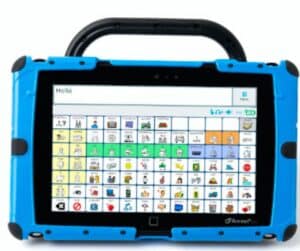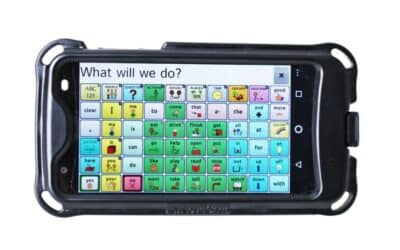In the modern world, technology has carved its way into almost every aspect of our lives, including how we communicate. For children with complex communication needs, the advent of Augmentative and Alternative Communication (AAC) devices has opened up a world of possibilities. Among the options, dynamic display voice output AAC stands out as a pivotal tool for many. In this article, we will answer the question, “How do dynamic display communication devices work?”
What is a Dynamic Display Device?
Augmentative and Alternative Communication also known as AAC refers to various methods of communication that can aid those who have speech and language impairments. A Dynamic Display AAC is a dedicated (only used for communication) device or software application on a tablet computer that showcases photographs, pictures and/or symbols on a screen. As the user selects these symbols, related vocabulary appears, offering a dynamic and changing page interface, hence the term dynamic display. In other words, related pages are linked to one another. This opens up broader vocabulary options for the user. If the child indicates, “I eat,” then their food choice page is displayed. Allowing them to expand upon their message and make it more specific.

Dynamic display devices have voice output or speech generation. Voice output allows the selected pictures or symbols that represent the words selected words to be spoken aloud. For children with speech or language challenges, this can be a groundbreaking way to effectively communicate their needs, wants, feelings, and thoughts. It can allow them to interact more with others and participate more fully in their family, school, and community.
Comparison: Dedicated AAC Device vs. AAC Application on a Tablet Computer
Dynamic display AAC devices are either “dedicated” or only used for the purpose of communication or made from AAC software loaded onto a cell phone or tablet computer. Each of these options can work extremely well. They both have advantages and disadvantaged as shown in the table below:
| Feature | Designated AAC Device | AAC App on Tablet Computer |
| Price | Typically more expensive | Often more affordable |
| Durability | Built for rugged use | May require additional protective case |
| Battery Life | Longer lifespan | Varies depending on tablet usage |
| Customization | Specific to communication needs | Highly customizable with various apps |
| Portability | Generally portable | Very portable |
| Software Updates | Routine updates through device | Regular updates through app |
Examples of Dynamic Display Device Use:
- Personal Interactions: A child can use the device to share their needs, wants, feeling, and ideas, initiate and participate in conversations, and much more. This is done by selecting individual pictures and symbol or series of pictures of symbols.
- Classroom Learning: A child can respond to and ask questions, interact with peers and adults, participate in discussions, request help, and more.
- Daily Needs: A child can use symbols and pictures to express different needs like hunger, thirst, and toileting as well as manners, affection, humor, wanting to go to a specific place, and so much more.

FAQs:
- What is a dynamic display AAC device?
- A dynamic display AAC device is an electronic tool that helps individuals with speech and language impairments communicate more effectively. Unlike static devices with fixed symbols, these devices have touchscreen displays that change and link one page to another expanding vocabulary option choices. They offer a wider range of symbols, words, or phrases.
- How can a dynamic display AAC device benefit my child?
- These devices can significantly aid children who have difficulty with spoken communication. They provide a platform for expressing needs, thoughts, and feelings. This enhances their ability to generate novel ideas and interact with others. Dynamic display devices are adaptable to the child’s changing needs and abilities.
- Is a dynamic display AAC device difficult for children to learn?
- This can vary depending on the child’s developmental level, motor control, the complexity of the device, and many other factors. Most devices and software applications are designed to be user-friendly and intuitive. With the right personalized guidance from an experienced speech-language pathologist, support and training for parents, educators, and caregivers, and consistent and appropriate access and practice, children can make remarkable strides with these devices.
- Can using an AAC device hinder my child’s speech development?
- There’s a common misconception that using AAC devices might prevent or reduce the development of speech. However, research has shown that AAC can support and even enhance speech development.
Additional Resources:
- Dynamic Display Devices | Assistive Technology Resources (cincinnatichildrens.org)
- Types of AAC – Communication Matters
- Augmentative Communication Devices (mo.gov)
- Communication-Systems-High-Tech-AAC-Devices-Info-Sheet-FINAL-Jan-2020.pdf (ilct.com.au)
- AAC Institute
- ASHA’s Augmentative and Alternative Communication (AAC)
- PrAACtical AAC
Summary/Conclusion:
Dynamic display Augmentative and Alternative Communication devices, whether dedicated or software application on a tablet, can be game changers for children with communication challenges. It’s essential to understand their features, benefits, and use. After the device has been selected by you and your evaluators and put in place, training, support, and continuous adaptation for the child and their communication partners are critical for successful use. Regular observation and assessments to evaluate the child’s progress and any necessary adjustments to the AAC system are vital. It’s also important to model AAC use and integrate the AAC dynamic display device into the child’s daily life. Engaging family members and educators in the process helps create a supportive environment that encourages communication and interaction, fostering the child’s overall confidence and efficiency using these AAC systems.




0 Comments